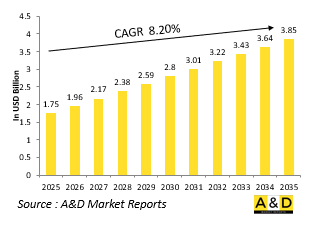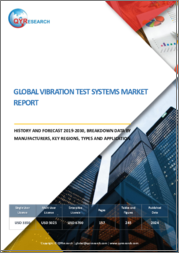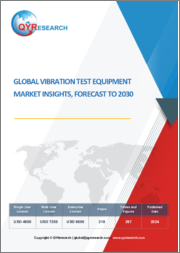
|
시장보고서
상품코드
1714094
세계의 진동 시험 장비 시장(2025-2035년)Global Vibration Test Equipment Market 2025-2035 |
||||||
전 세계 진동 시험 장비 시장 규모는 2025년 17억 5,000만 달러에서 예측 기간 동안 8.20%의 CAGR로 2035년에는 38억 5,000만 달러에 달할 것으로 예상됩니다.

진동 시험 장비 시장 : 소개
진동 시험 장비는 방위 산업에서 매우 중요한 역할을 합니다. 이는 미션 크리티컬 시스템이 작동 중 스트레스 조건에서도 기계적 견고성, 구조적 무결성 및 성능의 신뢰성을 유지할 수 있도록 하기 위함입니다. 항공기 항공전자 및 미사일 부품, 내환경 통신 시스템, 육상 이동 차량에 이르기까지 국방 플랫폼은 배치 중에 가혹한 진동 환경에 노출됩니다. 방위 분야의 진동 시험 장비 시장은 기계공학과 임무 보증의 교차점에 위치하고 있으며, 실제 상황에서 발생하는 충격, 충돌 및 지속적인 진동을 재현하는 시뮬레이션 기능을 제공합니다. 국방 시스템이 점점 더 복잡해지고 소형화되며 고정밀 허용 오차 범위와 다중 도메인 기능을 갖추게 됨에 따라 고급 테스트 인프라의 필요성이 증가하고 있습니다. 진동 시험 장비는 시제품 검증부터 최종 제품 인증, 운영 중 업그레이드에 이르기까지 제품 수명주기의 다양한 단계에서 사용됩니다. 방위 관련 계약업체, 정부 연구소, 항공우주 테스트 센터는 MIL-STD-810 및 NATO STANAG와 같은 국제 군사 표준에 대한 적합성을 검증하기 위해 이러한 장비에 의존하고 있습니다. 시장에는 전동 진동 셰이커, 유압 진동 테이블, 다축 시스템 등 다양한 기술이 있으며, 고정밀 분석을 위해 디지털 데이터 수집 시스템과 통합되는 경우가 늘고 있습니다. 국방 분야가 신속한 시스템 배포 및 수명주기 연장 전략으로 전환함에 따라 진동 시험 장비는 개발 위험을 줄이고 전투 준비성을 확보하는 데 필수적인 존재가 되고 있습니다.
진동 시험 장비 시장 : 기술의 영향
기술의 발전은 국방 분야에서 사용되는 진동 시험 장비의 기능과 성능 지표를 재정의하고 있습니다. 최신 시스템은 고해상도 센서, 실시간 제어 소프트웨어, 기계 학습 기반 분석 기능을 통합하여 보다 정확하고 적응력이 높은 테스트 환경을 제공합니다. 가장 혁신적인 변화 중 하나는 디지털 트윈 기술의 도입입니다. 이 기술은 부품이나 시스템의 가상 복제본을 진동 시나리오 시뮬레이션에 적용하여 물리적 파괴 없이 구조적 취약성을 파악하는 기술입니다. 이러한 디지털 시뮬레이션은 고주파 가속도계와 스트레인 게이지를 통해 얻은 물리적 테스트 데이터로 검증되어 설계를 개선하고 예지보전 모델을 강화하는 피드백 루프를 가능하게 합니다. 또한, 다축 가진 플랫폼으로의 전환으로 X축, Y축, Z축이라는 서로 다른 벡터의 동시 가진이 가능해져 공중, 해상, 육지를 막론하고 실제 전장의 움직임을 보다 사실적으로 시뮬레이션할 수 있게 되었습니다. 또한, 냉각 시스템과 동적 부하 제어의 혁신으로 극한의 발사, 비행, 수송 조건을 재현할 수 있는 고부하 전자기 가진기의 사용도 확대되고 있습니다. 또한, AI를 활용한 소프트웨어는 센서의 피드백을 기반으로 시험 파라미터를 실시간으로 자동 조정하여 시험 시간을 단축하고 정확도를 향상시킬 수 있게 되었습니다. 국방 연구개발이 보다 민첩하고 개발 주기를 단축하는 방향으로 나아가고 있는 가운데, 기술적으로 강화된 진동 시험 시스템은 점점 더 역동적인 군사 환경에서 신뢰성 보증, 구조 인증, 시스템 복원력을 실현하는 데 필수적인 요소로 부상하고 있습니다.
진동 시험 장비 시장의 주요 촉진요인:
몇 가지 전략적 및 운영적 요인으로 인해 전 세계 국방 분야에서 첨단 진동 시험 장비에 대한 수요가 증가하고 있습니다. 그 중 가장 대표적인 것이 현대 국방 시스템의 복잡성과 성능에 대한 요구가 증가하고 있다는 점입니다. 여기에는 예측할 수 없는 환경과 기계적 스트레스를 견뎌야 하는 소형 전자 어셈블리, 고정밀 유도 장치, 모듈식 구조 요소 등이 포함됩니다. 군이 더 가볍고, 더 민첩하며, 전자적으로 통합된 시스템을 추구함에 따라 이러한 구성요소가 진동 하에서도 기능적 무결성을 유지할 수 있도록 하는 것은 선택이 아닌 필수입니다. 특히 각국이 레거시 플랫폼을 단계적으로 폐기하고 새로운 테스트 프로토콜을 필요로 하는 차세대 차량, 미사일, 항공기로 전환하고 있기 때문입니다. 또한, 극초음속 무기, 재사용 가능한 우주 시스템, 무인 전투기(UCAV)에 대한 투자가 증가함에 따라 고속 통과, 대기권 재진입, 극한의 온도 변화 등 섬세한 서브시스템에 비할 데 없는 기계적 스트레스를 가하는 조건을 포함한 새로운 진동 테스트 파라미터가 도입되고 있습니다. 또한, 정부와의 방위 계약에서 환경 테스트 표준 준수가 점점 더 엄격해지고 있으며, 이에 따라 고성능의 인증 가능한 진동 테스트 솔루션의 사용이 요구되고 있습니다. 마지막으로, 구조적 건전성 모니터링과 예지보전을 통해 자산의 수명주기를 연장하는 데 중점을 두는 방위 산업의 증가는 심각한 고장이 발생하기 전에 작동 마모를 시뮬레이션하고 재료 피로를 평가할 수 있는 시험 장비에 크게 의존하고 있습니다. 이러한 요인들이 결합되어 진동 시험은 일상적인 검증 프로세스에서 방위 시스템 엔지니어링 및 수명주기 관리의 전략적 기능으로 변화하고 있습니다.
세계의 진동 시험 장비 시장을 조사했으며, 시장 현황, 기술 동향, 시장 영향요인 분석, 시장 규모 추정 및 예측, 지역별 상세 분석, 경쟁 구도, 주요 기업 개요 등의 정보를 전해드립니다.
목차
세계의 진동 시험 장비 시장 : 목차
세계의 진동 시험 장비 시장 : 보고서의 정의
세계의 진동 시험 장비 시장 : 세분화
지역별
유형별
장비 유형별
용도별
향후 10년간의 세계 진동 시험 장비 시장 분석
세계의 진동 시험 장비 시장 : 시장 기술
세계의 진동 시험 장비 시장 : 예측
세계의 진동 시험 장비 시장 동향과 예측 : 지역별
북미
촉진요인, 제약, 과제
억제요인
시장 예측·시나리오 분석
주요 기업
공급업체 티어 상황
기업 벤치마킹
유럽
중동
아시아태평양
남미
세계의 진동 시험 장비 시장 : 국가별 분석
미국
방위 프로그램
최신 뉴스
특허
현재 기술 성숙도
시장 예측·시나리오 분석
캐나다
이탈리아
프랑스
독일
네덜란드
벨기에
스페인
스웨덴
그리스
호주
남아프리카공화국
인도
중국
러시아
한국
일본
말레이시아
싱가포르
브라질
세계의 진동 시험 장비 시장 : 기회 매트릭스
세계의 진동 시험 장비 시장 : 보고서에 관한 전문가의 의견
결론
항공·방위 시장 보고서에 대해
ksm 25.05.14The Global Vibration Test Equipment market is estimated at USD 1.75 billion in 2025, projected to grow to USD 3.85 billion by 2035 at a Compound Annual Growth Rate (CAGR) of 8.20% over the forecast period 2025-2035.

Introduction to Vibration Test Equipment Market:
Vibration test equipment plays a critical role in the defense industry by ensuring the mechanical robustness, structural integrity, and performance reliability of mission-critical systems under operational stress conditions. From aircraft avionics and missile components to ruggedized communication systems and mobile ground vehicles, defense platforms are subject to harsh vibration environments during deployment. The global defense vibration test equipment market exists at the intersection of mechanical engineering and mission assurance, providing simulation capabilities that replicate shock, impact, and sustained vibration encountered in real-world scenarios. As defense systems become increasingly complex and miniaturized, with tighter tolerances and multi-domain functionality, the need for advanced testing infrastructure has intensified. Vibration test equipment is used across multiple phases of the product lifecycle-from prototype validation to final product certification and ongoing system upgrades. Defense contractors, government laboratories, and aerospace test centers rely on these tools to verify compliance with international military standards such as MIL-STD-810 and NATO STANAG protocols. The market includes a range of technologies, including electrodynamic shakers, hydraulic vibration tables, and multi-axis systems, which are increasingly integrated with digital data acquisition systems for high-fidelity analysis. As the defense sector pivots toward rapid system deployment and lifecycle extension strategies, vibration test equipment is becoming indispensable in reducing development risk and enhancing combat-readiness assurance.
Technology Impact in Vibration Test Equipment Market:
Technological advancements are redefining the capabilities and performance metrics of vibration test equipment used in the defense sector. Modern systems now integrate high-resolution sensors, real-time control software, and machine learning-based analytics to deliver more precise and adaptable testing environments. One of the most transformative shifts has been the incorporation of digital twin technology, where virtual replicas of components or systems are subjected to simulated vibration scenarios to identify structural vulnerabilities without physical destruction. These digital simulations are then validated with physical test data captured through high-frequency accelerometers and strain gauges, enabling a feedback loop that refines design and enhances predictive maintenance models. Additionally, the transition to multi-axis vibration platforms has allowed for simultaneous excitation along different vectors-X, Y, and Z axes-thereby providing more realistic simulations of actual battlefield motion, whether it be in airborne, seaborne, or land-based conditions. Innovations in cooling systems and dynamic load control have also expanded the use of high-force electrodynamic shakers capable of replicating extreme launch, flight, or transport conditions. Furthermore, AI-driven software can now automatically adjust test parameters in real-time based on sensor feedback, reducing test time and improving accuracy. As defense R&D moves toward more agile and accelerated development cycles, technology-enhanced vibration test systems are emerging as essential enablers of reliability assurance, structural certification, and system resilience in increasingly dynamic military environments.
Key Drivers in Vibration Test Equipment Market:
Several strategic and operational factors are propelling the demand for advanced vibration test equipment within global defense sectors. Chief among them is the growing complexity and performance demands of modern defense systems, many of which include compact electronic assemblies, high-precision guidance units, and modular structural elements-all of which must endure unpredictable environmental and mechanical stressors. As militaries pursue lighter, more agile, and electronically integrated systems, ensuring these components maintain functional integrity under vibration is not optional-it is mandatory. Another significant driver is the ongoing global push for defense system modernization and platform interoperability, particularly as countries phase out legacy platforms in favor of next-generation vehicles, missiles, and aircraft that require new testing protocols. In addition, increasing investments in hypersonic weapons, reusable space systems, and unmanned combat aerial vehicles (UCAVs) have introduced new vibration test parameters involving high-speed transit, atmospheric re-entry, and extreme thermal variation-conditions that place unparalleled mechanical stress on sensitive subsystems. Government defense contracts also increasingly specify stricter compliance with environmental test standards, which necessitates the use of highly capable and certifiable vibration test solutions. Finally, the defense industry's growing emphasis on extending asset lifecycles-through structural health monitoring and predictive maintenance-relies heavily on test equipment that can simulate operational wear and assess material fatigue before critical failure occurs. Collectively, these drivers are transforming vibration testing from a routine verification process to a strategic function within defense systems engineering and lifecycle management.
Regional Trends in Vibration Test Equipment Market:
The adoption and development of vibration test equipment in the defense sector varies across global regions, reflecting distinct national priorities, defense procurement strategies, and industrial capabilities. In North America, particularly the United States, defense agencies and prime contractors maintain some of the world's most sophisticated test facilities, supporting development of aircraft like the F-35, missile systems under the Missile Defense Agency, and space programs led by the U.S. Space Force. These facilities invest in cutting-edge vibration simulation infrastructure, often paired with climate chambers and EMI/EMC labs, to deliver comprehensive qualification processes. Canada also maintains an active role, especially in testing for NATO-interoperable systems and cold-weather stress applications. In Europe, countries like Germany, France, and the UK are investing heavily in vibration testing capabilities for joint defense programs like the Future Combat Air System (FCAS) and Tempest, while also supporting dual-use technologies for both military and civil aviation. European defense firms often collaborate with academic institutions and testing consortia, creating innovation clusters that advance vibration simulation methods and standards compliance. In the Asia-Pacific region, China and India are rapidly expanding their defense manufacturing bases and associated testing infrastructure. China, in particular, is building large-scale vibration and shock testing complexes to support the development of indigenous fighter aircraft, long-range missile systems, and space assets. India, through DRDO and ISRO, is enhancing its vibration test capabilities as it pushes toward strategic autonomy in defense production. Japan and South Korea, while smaller in defense output, lead in high-precision vibration systems used for naval and aerospace component qualification. In the Middle East, especially in countries like the UAE and Saudi Arabia, there is growing investment in establishing in-country test facilities as part of defense localization efforts. These regional trends suggest that while North America and Europe maintain leadership in vibration testing technology, Asia-Pacific and the Middle East are rapidly scaling up their capabilities to meet domestic manufacturing and strategic independence goals.
Key Vibration Test Equipment Program:
The impending deployment of the U.S. Army's Long-Range Hypersonic Weapon (LRHW), officially named "Dark Eagle," signals a significant shift in the dynamics of modern warfare. Expected to enter service by the end of fiscal year 2025, Dark Eagle marks the United States' official entry into the hypersonic missile arena-an area currently led by China and Russia. This development holds far-reaching implications for both U.S. military capabilities and the broader global strategic balance and deterrence posture.
Table of Contents
Global vibration test equipment Market - Table of Contents
Global vibration test equipment Market Report Definition
Global vibration test equipment Market Segmentation
By Region
By Type
By Equipment Type
By Application
Global vibration test equipment Market Analysis for next 10 Years
The 10-year Global vibration test equipment market analysis would give a detailed overview of Global vibration test equipment market growth, changing dynamics, technology adoption overviews and the overall market attractiveness is covered in this chapter.
Market Technologies of Global vibration test equipment Market
This segment covers the top 10 technologies that is expected to impact this market and the possible implications these technologies would have on the overall market.
Global vibration test equipment Market Forecast
The 10-year Global vibration test equipment market forecast of this market is covered in detailed across the segments which are mentioned above.
Regional Global vibration test equipment Market Trends & Forecast
The regional Global vibration test equipment market trends, drivers, restraints and Challenges of this market, the Political, Economic, Social and Technology aspects are covered in this segment. The market forecast and scenario analysis across regions are also covered in detailed in this segment. The last part of the regional analysis includes profiling of the key companies, supplier landscape and company benchmarking. The current market size is estimated based on the normal scenario.
North America
Drivers, Restraints and Challenges
PEST
Market Forecast & Scenario Analysis
Key Companies
Supplier Tier Landscape
Company Benchmarking
Europe
Middle East
APAC
South America
Country Analysis of Global vibration test equipment Market
This chapter deals with the key defense programs in this market, it also covers the latest news and patents which have been filed in this market. Country level 10 year market forecast and scenario analysis are also covered in this chapter.
US
Defense Programs
Latest News
Patents
Current levels of technology maturation in this market
Market Forecast & Scenario Analysis
Canada
Italy
France
Germany
Netherlands
Belgium
Spain
Sweden
Greece
Australia
South Africa
India
China
Russia
South Korea
Japan
Malaysia
Singapore
Brazil
Opportunity Matrix for Global vibration test equipment Market
The opportunity matrix helps the readers understand the high opportunity segments in this market.
Expert Opinions on Global vibration test equipment Market Report
Hear from our experts their opinion of the possible analysis for this market.












